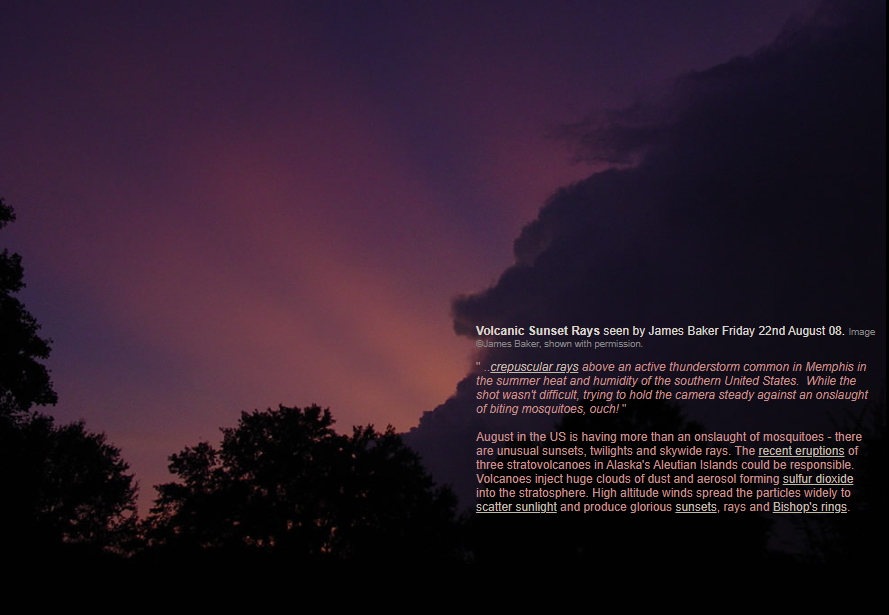Alaska Volcanoes
Alaska Volcanoes: A Spectacular Display of Atmospheric Optics
Alaska, known for its breathtaking landscapes and rugged terrain, is also home to a number of active volcanoes. These towering giants not only shape the landscape but also have a profound impact on the atmosphere above. The recent eruptions of three stratovolcanoes in Alaska's Aleutian Islands have resulted in some truly remarkable atmospheric phenomena, such as unusual sunsets, twilights, and skywide rays. In this article, we will delve into the fascinating world of Alaska volcanoes and explore the mesmerizing display of atmospheric optics they create.
When volcanoes erupt, they release massive amounts of volcanic ash, dust, and aerosols into the atmosphere. These particles, particularly sulfur dioxide, rise high into the stratosphere and are carried by high altitude winds, dispersing them over vast distances. As sunlight passes through these aerosol-laden clouds, it undergoes scattering, resulting in a variety of optical effects that captivate both scientists and nature enthusiasts alike.
One of the most striking phenomena caused by Alaska volcanoes is the creation of vibrant sunsets. The volcanic aerosols in the stratosphere scatter shorter wavelengths of light (such as blue and green) more effectively than longer wavelengths (such as red and orange). As a result, during sunrise or sunset, when the sunlight has to pass through a larger portion of the atmosphere, the shorter wavelengths are scattered away, leaving behind a magnificent display of warm hues that paint the sky.
In addition to vibrant sunsets, volcanic eruptions in Alaska also give rise to an enchanting phenomenon known as crepuscular rays. These rays, often referred to as "God rays," are beams of sunlight that appear to radiate from a single point in the sky. They are formed when sunlight is scattered by the volcanic aerosols present in the atmosphere. The scattering causes variations in the intensity of the light, creating a visually stunning effect that seems to converge at a distant point on the horizon.
Another fascinating optical effect associated with Alaska volcanoes is the formation of Bishop's rings. These rings, also known as aureoles, encircle the sun or moon and are caused by the diffraction of light as it passes through the volcanic aerosols in the atmosphere. The size and intensity of these rings depend on the size and concentration of the aerosol particles. When conditions are right, observers may witness a stunning display of concentric rings surrounding the celestial body, adding a touch of mystique to the already awe-inspiring volcanic landscapes.
The impact of Alaska volcanoes on atmospheric optics extends beyond just visual phenomena. The injection of volcanic aerosols into the stratosphere can have significant implications for climate and weather patterns. The sulfur dioxide released during volcanic eruptions can combine with water vapor to form sulfate aerosols, which act as nuclei for cloud formation. These aerosols can alter the properties of clouds, affecting their reflectivity and lifetime, ultimately influencing regional and global climate patterns.
Alaska's volcanoes are not only a sight to behold but also provide valuable insights into the intricate workings of our atmosphere. Scientists closely monitor these volcanic activities, using advanced instruments and satellite data to better understand the composition and behavior of volcanic aerosols. By studying the optical effects produced by these volcanoes, researchers gain crucial knowledge about atmospheric processes and their implications for our planet.
In conclusion, Alaska's volcanoes offer a mesmerizing display of atmospheric optics. From vibrant sunsets to captivating crepuscular rays and enchanting Bishop's rings, these volcanic eruptions create a symphony of colors and light in the sky. Beyond their visual appeal, these phenomena provide valuable insights into the complex interactions between volcanoes and the atmosphere. By studying these optical effects, scientists deepen our understanding of our planet's delicate balance and contribute to ongoing efforts in climate research. So, the next time you witness a stunning sunset or gaze upon a radiant display of crepuscular rays, remember that nature's artistic prowess is often shaped by the mighty forces beneath the Earth's surface.

Volcanic Sunset Rays seen by James Baker Friday 22nd August 08. Image ©James Baker, shown with permission.
" ..crepuscular rays above an active thunderstorm common in Memphis in the summer heat and humidity of the southern United States. While the shot wasn't difficult, trying to hold the camera steady against an onslaught of biting mosquitoes, ouch! "
August in the US is having more than an onslaught of mosquitoes - there are unusual sunsets, twilights and skywide rays. The recent eruptions of three stratovolcanoes in Alaska's Aleutian Islands could be responsible. Volcanoes inject huge clouds of dust and aerosol forming sulfur dioxide into the stratosphere. High altitude winds spread the particles widely to scatter sunlight and produce glorious sunsets, rays and Bishop's rings.
Note: this article has been automatically converted from the old site and may not appear as intended. You can find the original article here.
Reference Atmospheric Optics
If you use any of the definitions, information, or data presented on Atmospheric Optics, please copy the link or reference below to properly credit us as the reference source. Thank you!
-
<a href="https://atoptics.co.uk/blog/alaska-volcanoes/">Alaska Volcanoes</a>
-
"Alaska Volcanoes". Atmospheric Optics. Accessed on November 26, 2024. https://atoptics.co.uk/blog/alaska-volcanoes/.
-
"Alaska Volcanoes". Atmospheric Optics, https://atoptics.co.uk/blog/alaska-volcanoes/. Accessed 26 November, 2024
-
Alaska Volcanoes. Atmospheric Optics. Retrieved from https://atoptics.co.uk/blog/alaska-volcanoes/.